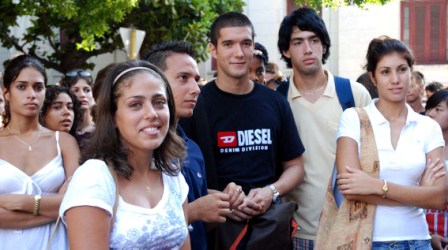Choices for Cuban Youth
Osmel Almaguer

Small food establishments that offer products in hard currency constitute the main recreational alternative for Cuban youth today.
At night Havana is totally to dark. It seems like a cinema when the lights are turned off before the movie begins, only that in this case only one small almost imperceptible activity can be noted in a few locations of the city.
With the arrival of the Special Period crisis of the 1990s —a time I will refer to below as being the point of demarcation between “before” and “after”— the holding and trafficking of hard currency was decriminalized across the entire island. This was part of a policy of “flexibilization” that was pursued with the aim of reviving the economy.
With the possibility of possessing dollars, the green bills became the sole friends capable of providing articles of vital importance – like soap, food or deodorant. However not everyone could access these; for most people the only green they held was the hope for improvements, which have dried up over time.
Money sent by relatives abroad, prostitution and later on various jobs with joint-venture companies or in tourism were the sole sources of hard currency for ordinary people. To those have been added theft and corruption, which occur in almost all workplaces whether these are goods-producing enterprises or not.
At that time (the early 90s), an entire network of establishments was created to collect hard currency from that minority sector that had access to the dollar. Through all of this, sharp differences were created between people, ones that are much deeper today.
Dollar stores, kiosks and eating establishments were given all types of names (Infotur, Rapidito, Ditu, etc.). In addition, the great majority of restaurants, not to mention hotels, began to conduct business solely in hard currency.
At one point the value of one dollar ended up being equal to more than a hundred Cuban pesos. There was a time in which food was scarce all over Cuba, however food service in hard currency was organized (and still is) openly in public places. Those who ate and could drink “forbidden” beer did so smugly, in their pleasure in consuming what the majority of people couldn’t.
With time this situation has relaxed, though I cannot affirm that all is well. The issue of food has ceased to be critical, and for a good while now the public has begun to once again think about leisure activities, recreation and having a good time.
In the “before” times, in addition to having variety of alternatives and plenty of places for recreation, people had a different concept of amusement. Back then people spoke of going to the cinema, to the Coppelia ice cream park or sitting out on the Malecon seawall, and these were engaged in without qualms. In the “after” period, such activities are done by “washouts,” meaning those who don’t have enough hard currency. “Before,” people talked about going to the theater or eating at a restaurant, at one in Lenin Park or at the Zoo.
Later discos became almost the sole alternative preferred by youth. Few were interested in the cinema because almost all the movies that came out could be seen on DVD. Cuban youth have gone through a process of marginalization. It is a nascent generation that has seen its future frustrated by economic problems. It has moved closer to the subculture of reggaeton because the internal conditions of that generation are ideal for it.
But apparently the authorities have preferred to “ignore” the problems of youth; so in each cheap disco we’re now discovering marijuana and worse drug. Instead of taking more healthy measures around the youth recreation, the issue seems to be closed. That’s why sound recreational alternatives, those in which people can discharge their tensions of the week, are increasingly fewer and poorer.
It’s now common for the different sectors of youth —who “before” were homogeneous— to meet up at different places across town. This of course frightens the authorities, who fear almost any community of interests that’s not the one desired by their higher-ups.





